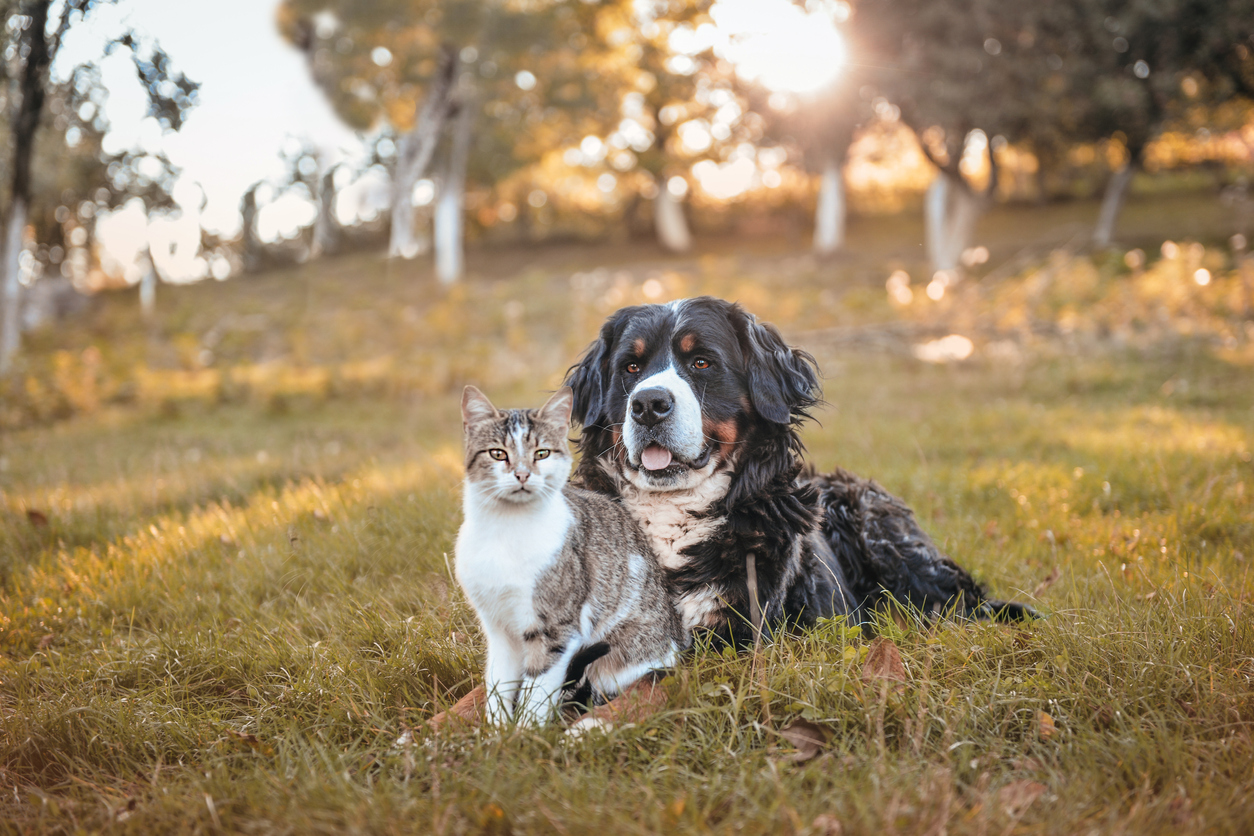

Pet Health
Sections

How Supplements Support Pet Health
As pet owners, we want the best for our furry friends. Whether we get our dog or cat when they’re a baby, adult, or senior, one of your first purchases (aside from toys) will be pet food and yummy treats.
But a super important part of your pet’s diet that is often overlooked and is an essential part of pet health is pet supplements.
Just like people, our four-legged family members are unfortunately prone to various health issues, and we want to make sure we do everything we can to prevent these issues. If we can’t stop diseases and other ailments, we want to at least do our best to give our pets the comfort and relief they need and deserve.
Like you, your dog or cat can benefit from taking supplements, as they can help prevent pet health problems that their breed is prone to or simply help them stay in tip-top condition as they age.
In other words, supplements can help make your dog or cat stronger, faster, better!
Ok, maybe supplements won’t give your pet super powers. But as long as you’re giving them ones backed by science and that don’t add anything harmful to your pet’s diet (like a known allergen), then you’re golden.
Choosing the right animal supplements to support your pet’s health requires a bit of education, including learning how to read a supplement label and avoiding supplements that contain ingredients that may be harmful to your pup (which we’ll get into more detail later in this article).
Joint health issues in cats and dogs are extremely common, so one of the supplements we’ll focus on quite a bit in this article is joint supplements, as they help prevent or treat joint-related conditions in dogs and cats, giving them a better quality of life.
Let’s start by taking a step back and answering some common questions about animal supplements for pet health, starting with their safety.

Are Animal Supplements Safe?
For the most part, animal supplements are safe, but it’s essential to recognize that there are loose regulations surrounding them.
Supplements for animals and humans don’t require the US Food and Drug Administration (FDA) to determine the effectiveness and safety of a supplement product before it’s marketed to the public. That may seem surprising, but it’s because supplements are regulated by the FDA as food, rather than drugs. This means that there are specific regulations that supplements do need to observe, like making sure all ingredients are on the label, but these regulations are often not enough.
Many studies and professional opinions suggest that more research and oversight are needed to ensure that supplements contain what they say they contain and that they are accurately labeled so that consumers can fully understand what they are giving their pets.
In Canada, animal supplements are not regulated because they are considered low-risk veterinary products. However, Health Canada can still approve veterinary products, provided they meet the strict requirements. TRI-ACTA and TRI-ACTA H.A. are approved by Health Canada as designated Veterinary Health Products (VHP). Integricare also follows Good Manufacturing Practices (GMP), meaning our supplements are made with the highest quality ingredients with no fillers. Our clear labels make it easy to verify ingredients, so you know exactly what you’re giving to your pet.
TRI-ACTA for Pets
A proactive approach for developing and younger adult pets to maintain optimal joint health mobility, minimize inflammation and fend off age-related ailments.
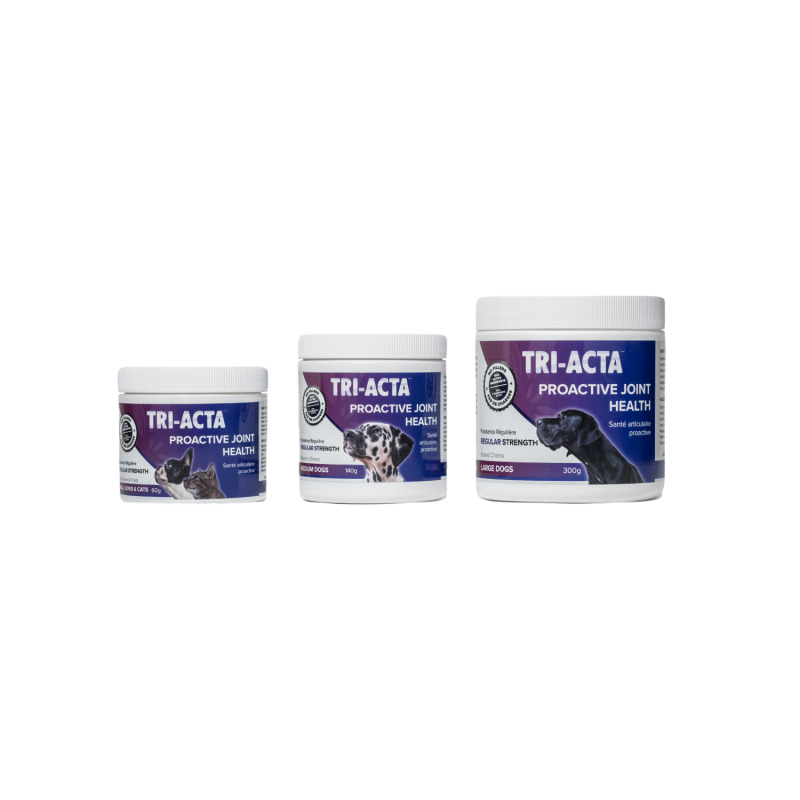
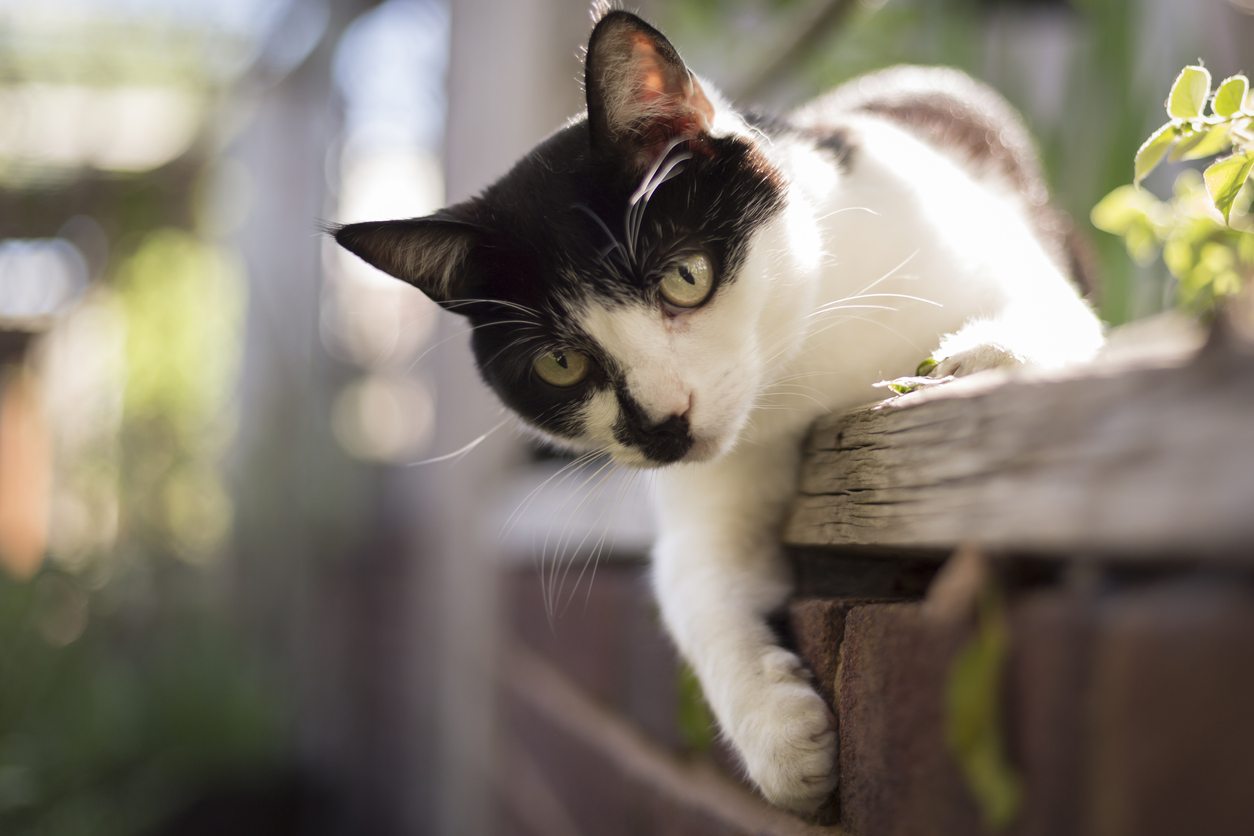
Why Are Pet Joint Supplements Recommended?
It may surprise you to learn that approximately 60-90% of older cats have osteoarthritis. In addition to that, one in five dogs will experience arthritis in their lifetime. In other words, joint issues in our beloved pets are much more common than we think.
To give our pets the most comfortable life possible and help prevent or treat joint issues, using joint supplements is often recommended to support overall pet health.
Pet Joint Problems
Some of the most common health problems that our furry family members suffer from are Luxating Patella, Arthritis, and Ligament Strains and Injuries. These ailments are often associated more frequently in larger-breed dogs but can also occur in small to medium-breed dogs and cats.
Joint Problems in Dogs

Dogs can suffer from a wide variety of joint problems. The most common ones are described in more detail in this section.
1. Luxating Patella

This is one of the most common pet health issues that dogs face, and it can affect older and younger dogs alike.
The patella is another name for the kneecap. In the case of a luxating patella, the kneecap slips out of place and sits at the side of your dog’s leg instead of centered over the front of the leg.
When the kneecap slips out of place, you’ll notice your dog holding its leg up. Some dogs find this condition painful; you may hear them whimper. Other dogs don’t display any signs of pain, but there is obvious discomfort in their walk, exhibiting itself in such symptoms as limping.
Patellar Luxation primarily affects small dogs such as Yorkies, Chihuahuas, Boston Terriers, and Miniature and Toy Poodles. Larger dogs are not exempt, but it does tend to be less prevalent in them.
Symptoms of Luxating Patella
A few symptoms of this condition include:
- Improper development of the joints
- Bowlegged stance
- Cracking or popping noises in the knee
- Limping
- Lifting of hind leg
- Skipping or hopping
Prevention of Luxating Patella
Preventing Patellar Luxation isn’t always possible, but the progression can be slowed, and the severity lessened. This will thereby make life more comfortable for your precious pooch.
Some ways you can prevent and/or slow progression are:
|
Preventative Measure |
Reason |
|
Regular, appropriate exercise |
Regularly take your dog on walks, and let them run—according to their comfort level. Swimming is also a good exercise that some dogs enjoy. |
|
Feed a well-balanced diet |
Maintaining a healthy weight is paramount. Overweight dogs will have more problems with a luxating patella, as well as other orthopedic issues. |
|
Avoid jumping from high places |
As dogs get older, their leaps from the couch or down the stairs will become more stressful and create too much impact on their joints. Giving them the option for doggy stairs to get off the couch, for example, can help prevent jumps that could damage their knees. |
|
Give supplements to support joint health |
Many have found that supplements can offer the needed support to help your dog’s joints stay healthy. Consult your veterinarian before giving any over-the-counter supplements. |
Fortunately, Patellar Luxation isn’t life-threatening, and most dogs continue to live full, happy lives even with the condition. However, you do want to do all you can to alleviate the discomfort it does present.
2. Arthritis
As dogs get older, arthritis is one of the conditions that not only humans face. This is particularly prevalent in larger dogs that have more weight to support – such as Bernese Mountain Dogs and Great Danes.
Approximately 25% of dogs are diagnosed with arthritis in their lifetime. Over the years, there is a slow degeneration of soft tissues that typically cushion the joints. These can result in swelling, stiffness, and pain.
Symptoms of Arthritis
Signs of the onset of arthritis include:
- Your dog gets up and moves slowly, especially at the start of their day
- A reduction in range and/or level of movement
- Swelling and pain in the joints
Prevention of Arthritis
Unfortunately, arthritis cannot be completely prevented, but you can delay the onset and make your pet comfortable.
Some steps you can take are:
- Gentle exercise: Keeping the joints in motion helps them from becoming too stiff for your dog to move around comfortably.
- Don’t overexert: Don’t allow your dog to overexert themselves. It may sound counteractive to the previous point, but it’s all a matter of balance. You want them to exercise comfortably but without stressing the joints to the point of irritation.
- Provide an orthopedic bed: Most dogs love a new bed! Orthopedic beds not only support the joints but have a certain firmness that makes it easier for dogs to get up. Many think softer beds would be better for their ageing pet, but this isn’t entirely true. While they’re soft, they also tend to make it more difficult for dogs suffering from joint pain to get up because their weight sinks into the material, and they have to work harder to pull themselves up. Firmer beds give support to help them get up easier.
- Daily joint supplement: TRI-ACTA is a great choice. With only active ingredients (no fillers or additives) you can give your pet maximum joint protection in every dose. The combination of glucosamine, Chondroitin, and MSM keeps your pet’s joints healthy and strong as they age.
Consult your veterinarian, who may be able to suggest supplements that can even further help your dog feel their best.
3. Ligament Strains and Injuries

This injury is particularly concerning for dogs involved in sports or competitions such as racing, sledding, agility, or hunting. Golden and Labrador Retrievers, Siberian Huskies, and Greyhounds are just some of the breeds typically involved in sports.
But your Bulldog exuberantly running across the slippery kitchen floor at the sound of his treat bag can also easily suffer a ligament injury.
Symptoms of Ligament Strains and Injuries
Several factors can contribute to ligament strains and injuries including:
- Uneven terrain while running or playing
- Sudden, fast movements—whether these be in agility or a sudden turn in racing dogs
- Musculoskeletal abnormalities
- Previous injury
- Being overweight
Prevention of Ligament Strains and Injuries
Dogs can be unpredictable in their movements sometimes, so it may not always be possible to make sure they don’t move in ways that can injure them. However, we can help prevent these injuries when it comes to training for competitions.
You can help avoid ligament injuries by taking care to:
- Train on even surfaces. Uneven terrain may be unavoidable at times, especially in a hunting situation. However, ensuring your dog trains and hunts on even ground can help prevent injuries.
- Healthy weight. Ligaments that have to support a lot of weight are more susceptible to injury. Feeding a balanced diet and making sure your dog stays at a healthy weight can do a lot to prevent injuries.
- Be careful during play. Dogs with high energy in play, like Boxers, Pit Bulls, and Terriers, often play non-stop, even if they may have injured themselves. Give them breaks and watch for any signs of injury. This can help prevent a small, minor injury from becoming something more serious.
Giving your dog a joint supplement will also help protect their joints during exercise and play, and if they compete in sports. Joint supplements like TRI-ACTA help support the joint structures in your dog’s body, reducing the chances of developing a ligament injury.
TRI-ACTA does this through the combination of glucosamine, chondroitin, and MSM, a naturally-occurring anti-inflammatory, to lubricate joints as well as promote the development of new cartilage, muscle, and ligaments in the joint.
Joint Problems in Cats
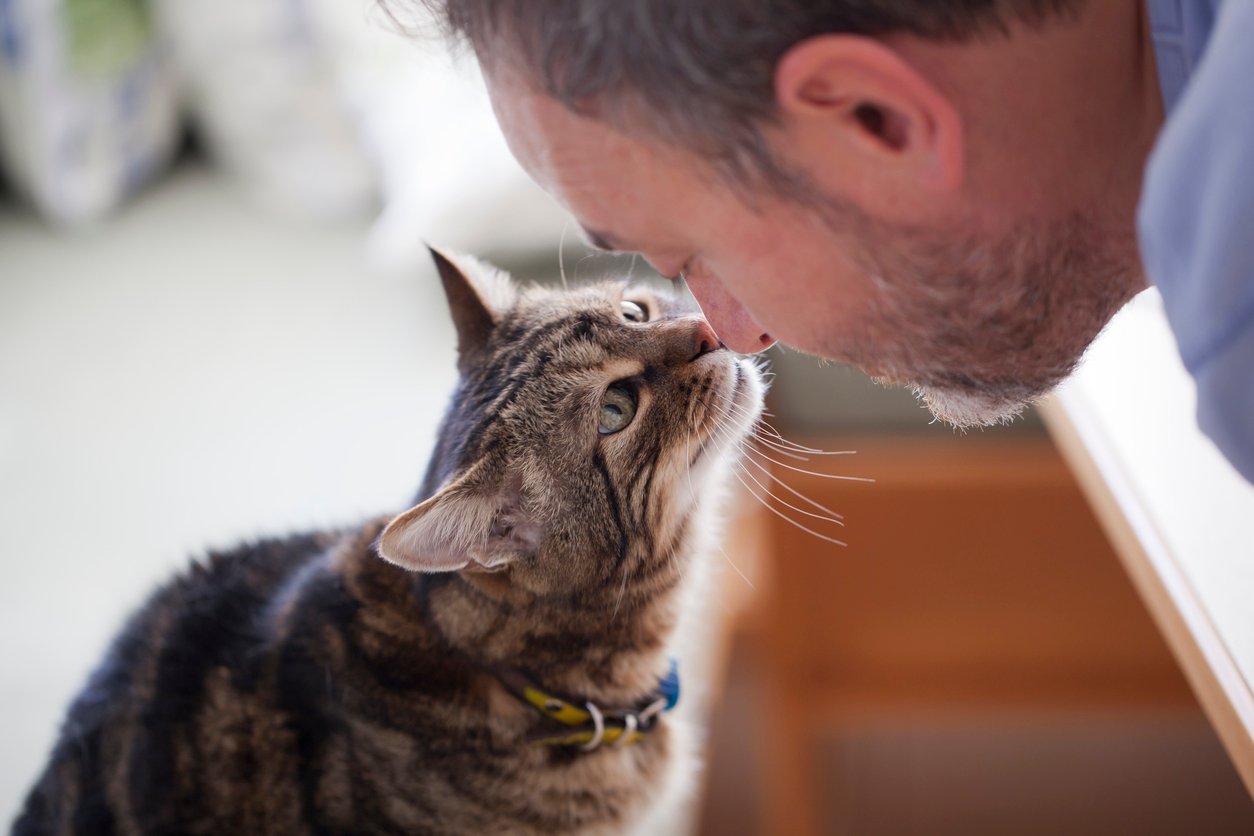
We would like to think that our feline friends have nine lives—and so would they! However, they’re still susceptible to some of the same health problems as their canine counterparts.
With all of the running through the house at their ‘witching hour’, jumping from ungodly heights, and their affinity for getting themselves in tight, odd spaces, it’s no wonder our cats are prone to several musculoskeletal issues.
Some common issues that affect cats are Arthritis, Hip Dysplasia, and Ligament injuries.
1. Arthritis
As our cats age, as much as they don’t want to, they’ll inevitably start to slow down. Cats already love sleeping and lounging around, but you’ll find your ageing cat will start to do this all the more. While advancing age is a factor, arthritis could be too.
Symptoms of Arthritis
Symptoms that may indicate arthritis in your cat are:
- Stiff or sore, swollen joints
- A stiff walk
- Reluctance to jump
- Behavioural changes (often in response to pain)
- Changes in grooming behaviour (due to pain or discomfort when in certain positions)
Prevention of Arthritis
Arthritis may become part of your cat’s life as they age. However, you can take steps to delay the onset and provide needed comfort and relief from their symptoms.
|
Preventative Measure |
Reason |
|
Provide a healthy diet |
Obesity can put stress on already ageing joints. A healthy diet will help them maintain a good weight and put less stress on their joints. |
|
Discourage high jumps |
Cats have a mind of their own. However, making certain areas with potentially dangerous jumps inaccessible can prevent joint injury. Provide a cat tree and entice them with some of their favourite treats or toys so they use that instead of jumping from the top of your armoire. |
|
Consider supplements |
Supplements containing glucosamine, chondroitin, and MSM will protect your cat’s joints and muscles. Integricare’s TRI-ACTA H.A. is specifically designed for pets who suffer from arthritis. Its high-concentrated active formula improves mobility, minimizes inflammation, and promotes healing. |
2. Hip Dysplasia
When it comes to the issue of hip dysplasia, people typically think of large-breed dogs. But our feline family members are also prone to this condition—and it’s really no wonder.
With all of the acrobats and antics that cats accomplish on an almost daily basis, it’s no wonder they wind up with problems like these. Because of their large size, Maine Coons tend to be particularly prone to this condition. In fact, about 20% of purebred cats suffer from Hip Dysplasia.
Hip dysplasia is when the ball and socket in the hip joint are misaligned and loose. This prevents the femoral head from moving smoothly and can lead to early-onset arthritis.
Symptoms of Hip Dysplasia
It may not be as easy to decipher if your cat is suffering from hip dysplasia, as it’s typically easier for them to mask symptoms of illness more than dogs do.
Some signs to look out for:
- Limping
- Difficulty getting up and moving around
- Avoiding certain kinds of movements (jumping from certain heights, climbing, etc)
- Problems with using the litter box (this is particularly the case if you use special types of litter boxes that require your cat to climb a bit higher)
The most common form of correction is surgery, otherwise, it can cause problems later on in your cat’s life.
Prevention of Hip Dysplasia
Because this is a physical deformity that occurs from birth, it’s not really possible to prevent the condition. However, you can slow down its progression and help make your cat more comfortable.
Consult your veterinarian should you notice any of the signs of hip dysplasia. By catching it early, your vet can recommend a course of treatment that will make your cat more comfortable and improve its quality of life.
Should your cat be diagnosed with hip dysplasia, being it can be passed on in genes, it’s especially important that your cat be spayed or neutered.
3. Ligament Injuries
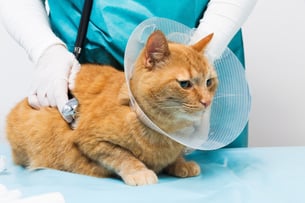
This is another common injury because of a cat’s penchant for jumping from extreme heights.
Ligaments are connective tissues in the cat’s musculoskeletal system that connect bones. They help keep bones from making exaggerated movements that could cause breakage.
Symptoms of Ligament Injuries
One of the most common ligament injuries is that of the anterior cruciate ligament – more commonly referred to as the ACL. This ligament is located in the knee joint and can be quite painful for your cat.
Treatment for this type of injury typically involves surgery and several weeks of rest for your cat.
Prevention of Ligament Injuries
Fortunately, preventing a torn ACL and other ligament injuries is possible.
You can take such steps as:
- Make sure to keep your cat at a healthy weight. Overweight cats are more prone to ACL tears and other ligament injuries than their healthy-weight counterparts. Providing a balanced diet will help ensure their weight remains in a healthy range.
- Try to keep your cat from unusually high places. This is understandably easier said than done! Discourage them from jumping from these heights by providing climbing frames to entice your cats.
- Try and keep things that your cat can become entangled with from being accessible. Though cats love to play with string—and just about anything else they can get their paws on, these can sometimes cause injury if they become entangled with them. Close closet doors where you may store yarn. Keep them out of garages where you keep twine, for example.
With a few preventative measures, you can help, at least to the best of your ability, to keep your feline companion from suffering a painful ligament injury.
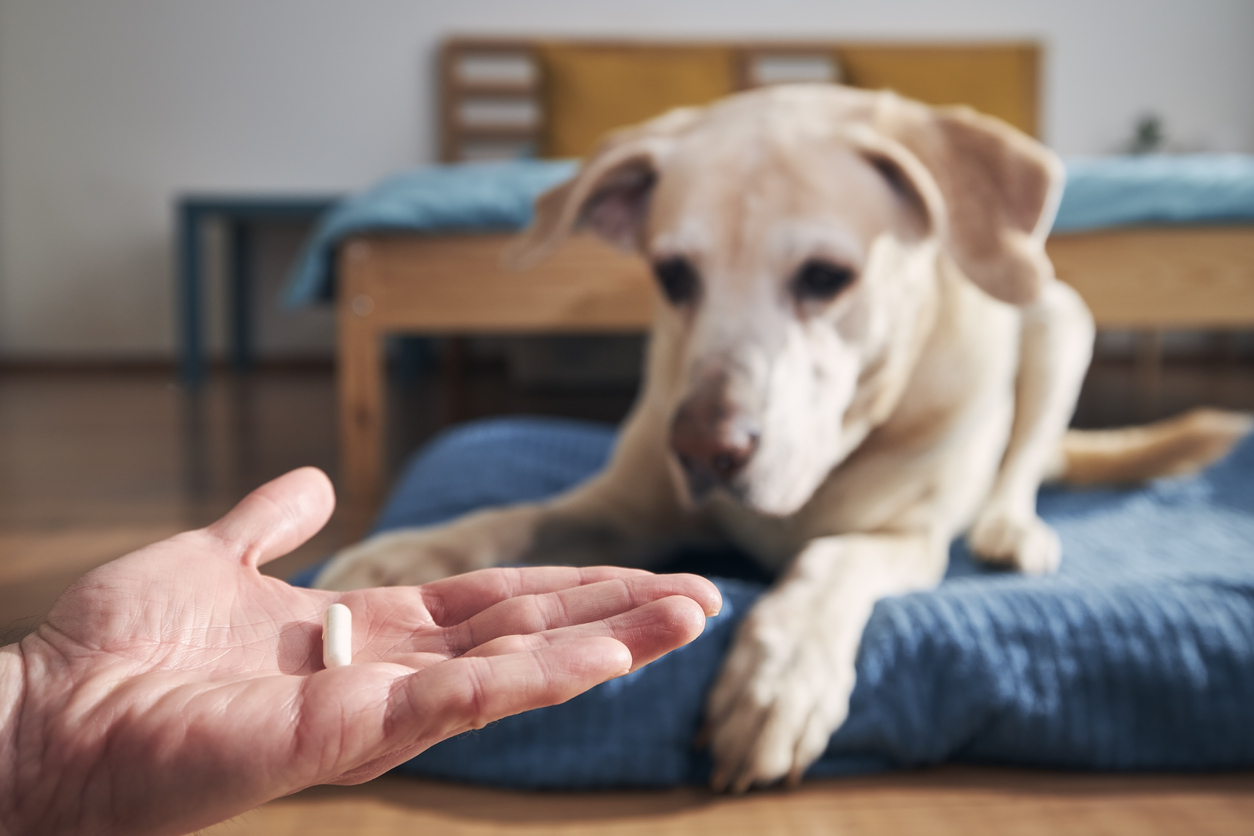
Types of Pet Joint Supplements
Pet joint supplements are made in various different forms, including powders, liquids, injectables, chews, and capsules.
Powders are very easy to administer—they typically come with a measuring scoop and can be easily disguised in your pet’s food. They are relatively easy to transport and store without worrying about liquid spills. Plus, powders are highly absorbable in your pet’s body, meaning they start to work faster.
However, even with these positives, there are some drawbacks. Powdered pet joint supplements can contain excipients—which are chemicals that help make manufacturing easier. Unfortunately, these chemicals have no benefit to your pet, and there’s some debate as to whether commonly used ones, like magnesium sterate, are harmful. Many powdered supplements also contain sweeteners to enhance flavor, which isn’t the best option for pets with conditions like diabetes.
Liquids are similar to powders in that they are easy to administer. One of the main advantages of liquids is that they can be formulated in different concentrations.
However, this also means they have a higher risk of causing an upset stomach and other gastrointestinal issues, so giving liquid supplements with food is often recommended. Thankfully, liquid pet supplements often come with a syringe or pipette to make extracting the correct dose and adding it to food or water easily. Liquid pet supplements often contain stabilizers to extend the product's shelf life, which, like excipients in powdered supplements, can potentially have harmful side effects for your pet (e.g., allergic reaction).
Chews are a popular choice for pet supplements because they act like a treat for your pet. They are often well-received by pets because they taste great, and it’s easy to ensure your pet gets the correct dose. For pets with dental problems, soft chews are a great choice because they are easy to eat.
However, pet chew supplements can be lacking in some essential minerals—like magnesium and zinc—because it’s tough to disguise the taste. Further, they contain sweeteners and artificial flavors to make them more appealing to your pet, which increases the chance of allergens and other negative effects. Fillers are often also present that would be unnecessary if the supplement was in a different format, like powder.
Capsules are another form of pet supplement. They contain powdered ingredients that are surrounded by a casing, often made from animal gelatin or plant-based cellulose. Because the ingredients are contained in a capsule, it helps mask the odors of them, making it easier to disguise the capsule in food or treats. Further, the capsule’s casing protects the ingredients from pre-mature digestion, enhancing the likelihood of being appropriately absorbed.
When ingested, the capsule dissolves in your pet’s stomach, releasing the contents. One of the benefits of capsules is that the dose is always correct—as long as your pet eats the entire pill. But, they are probably the most difficult to administer to your pet, as they often avoid swallowing it. Hiding the capsule in a treat or in food is generally effective, but some pet owners still have administration issues.
Injectables are pet supplements that are delivered intravenously or through a shot. They are an excellent option for pets that won’t take oral supplements or need a larger dose or a dose that lasts longer compared to an oral supplement. Injectables can be administered directly to an affected area, like the muscle or joint tissue, for maximum effect. But, because they can be tricky to administer, a vet often gives injectables.
Repeated visits to the vet to get injectable pet supplements can be costly, and it can be a bit painful or uncomfortable for your pet.
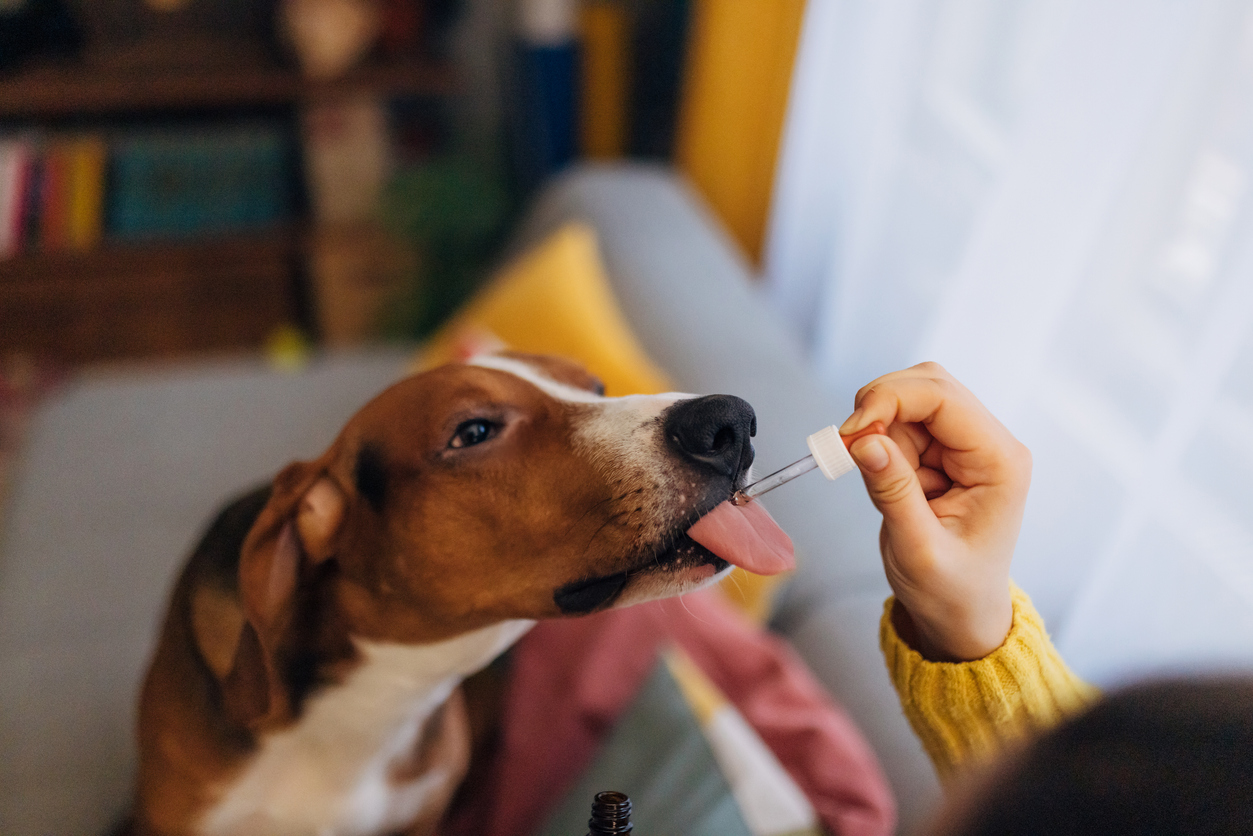
How to Choose a Pet Joint Supplement
With so many pet joint supplements on the market with so many price points, how do you know which one is best for your dog or cat? One of the most important things to consider is the ingredients. But reading supplement labels can be challenging. What’s good? What’s bad?
Here is a list of common ingredients found in pet health products and supplements. While some of them are not great additions, others have benefits. By understanding what an ingredient label is saying, you can make better decisions about the products you give to your pets.
Fillers
These additives increase the volume of the supplement. Examples of fillers that you may find in pet health supplements include:
- Cornstarch
- Lactose
- Cellulose (usually plant or animal-based material)
- Sorbitol (a sweetener; often used to preserve moisture and add texture)
- Calcium phosphate
Binders
These components are often used with tablets and chews to hold the ingredients together. Binders include:
- Honey
- Sorbitol
- Gum Arabic (hardened sap of either the senegalia senegal or vachellia seyal trees, which are two types of gum trees)
- Cellulose
- Lecithin (a mixture of fats)
Flavourings and Sweeteners
Just like children, pets aren’t going to want to take a supplement if it doesn’t taste good. Flavourings and sweeteners are fine in small amounts. However, some pets can have adverse reactions to some flavourings and sweeteners. For instance, maltodextrin can cause bloating, vomiting, and stomach upset. Not all animals will experience these issues, but it’s important to be aware of what’s in your pet health products so that you can better identify the cause of any problems that arise.
Types of flavourings and sweeteners commonly found in pet food and pet health supplements include:
- Sucrose
- Fructose
- Maltodextrin
- Sorbitol
- Maltrin
Disintegration Aids
Disintegration or dissolving components help capsules break apart in your pet’s digestive system so that the beneficial pet health ingredients can be absorbed properly. Examples of disintegration aids include:
- Alginic acid (a starch that occurs naturally in brown algae)
- Crospovidone (a synthetic, water-soluble polymer)
- Sodium carboxy-methylcellulose (a type of salt)
- Croscarmellose sodium (a polymer of carboxy-methylcellulose sodium)
- Sodium starch glycolate (a chemical modification of starch that promotes rapid disintegration)
Lubricants and Flow Agents
These components help release tablets from molds and dies during the manufacturing process and help increase the time it takes for tablets to dissolve. This is beneficial to ensure that the supplement gets to the area it needs for maximum absorption by your pet’s body.
Most lubricants and flow agents are made of vegetable components, with corn being the most common:
- Silica
- Vegetable stearate (a stearate is a type of salt or acid)
- Magnesium stearate
- Calcium stearate
- Stearic acid
- Polyethylene Glycol (a type of polymer used for thickening)
Colouring Agents
The colour of a pet heath product isn’t of any concern to your dog or cat—it’s about being attractive to you. If a pet health supplement is a gross brown or green colour that we associate with something toxic or rotten, we might be unconsciously drawn away from it. Manufacturers know this, so they’ll colour the product to make it look better.
Colouring agents that are common in pet supplement manufacturing include:
- Red, yellow, and black iron oxides
- Sunflower, canola, and soy-based lecithins
- Colours derived from beet, carrot, or chlorophyll
If dyes are deemed “generally safe to use” by the FDA in the United States, they can be used in pet health and food products sold there. In Canada, there is a list of permitted colouring agents that can be used in these products, with restrictions on how much can be used of each. Some agents are deemed better than others and thus fall under the GMP standard.
Coating Materials
To prevent a pet health product from drying out, going bad prematurely, or breaking apart (tablets and chews), or to mask unpleasant odours or tastes, coating materials may be used.
Common coatings that are used for pet health products include:
- Poultry-based fats
- Marine-based oils
- Antioxidants
- Palatants (appeals to a pet’s sensory capabilities—taste, smell, texture)
Preservatives
To extend the shelf life of a pet health product, preservatives will often be used. They are almost always synthetic, but some brands prioritize natural preservatives (although they may not be as effective as synthetic ones).
Synthetic preservatives often found in pet health products include:
- Ethoxyquin
- Butylated hydroxyanisole (BHA)
- Butylated hydroxytoluene (BHT)
These preservatives are great at preventing products from becoming rancid, but they have been linked to health problems in pets, especially when ingested in large quantities.
On the other hand, natural preservatives often found in pet health products include:
- Vitamin E (mixed tocopherols)
- Plant extracts (e.g., rosemary)
- Vitamin C (ascorbic acid)
These preservatives are better for your pet but don’t offer the shelf-life longevity benefits of the synthetic preservatives. If you’re buying pet health supplements with natural preservatives, it’s best to purchase smaller quantities at a time so that the product doesn’t go bad.
Gums
It might remind you of chewing gum, but the gums used in pet health products are very different from the tasty human treat—instead, they act as thickening or binding agents.
The most common gums used in pet health products, supplements, and foods are seed gums such as Guar, Carbob, Cassia, and Tora (often used in wet food for dogs and cats).
These gums do have pet health benefits as well. Seed gums help lower blood cholesterol, and give pet food better texture and taste while preserving its nutritional benefits.
The Bottom Line in Choosing a Pet Joint Supplement
You may look at a supplement and think it’s a better value because it has more volume for the price, but look again: if there are a bunch of fillers listed in the ingredients, you’re not getting the value you’re hoping for. Instead, look for an option with as few ingredients as possible.
And just as there are ingredients you want to avoid, there are also those you don’t want to do without:
|
Ingredient |
Function |
|
Glucosamine |
A component necessary for cartilage development. It can also help in the development of collagen, which is also extremely important for joint health. |
|
Chondroitin |
Slows down and neutralizes destructive enzymes in the joint. By doing this, it also acts to prevent the breakdown of cartilage. |
|
MSM |
MSM is a detoxifier. It’s a powerful antioxidant and can provide relief from pain and inflammation. |
|
Hyaluronic Acid |
This is a glucosamine compound. It occurs naturally in joint fluid and acts as a shock absorber. In older and arthritic pets, the concentration is reduced. Supplementing with HA increases this cushion in the joints and contributes to your pet's comfort. |
TRI-ACTA includes all of these ingredients except for hyaluronic acid, which is included in our TRI-ACTA H.A. maximum strength product.
While both products can be used as a preventive supplement to help your dog or cat avoid joint health issues, TRI-ACTA is meant proactively for animals that don’t yet have joint health issues or minor ones, while TRI-ACTA H.A. is intended for animals experiencing joint pain.
TRI-ACTA H.A. aids in the recovery process by adding more lubrication properties to your pet’s joints and assisting in the formulation of cartilage, ligaments, and tendons. It can be given to your pet alongside NSAIDs or on its own.
TRI-ACTA H.A. for Pets
Our maximum strength formula is optimally designed to accelerate the formation of cartilage, minimize inflammation, expedite the healing process, and improve joint conditions.
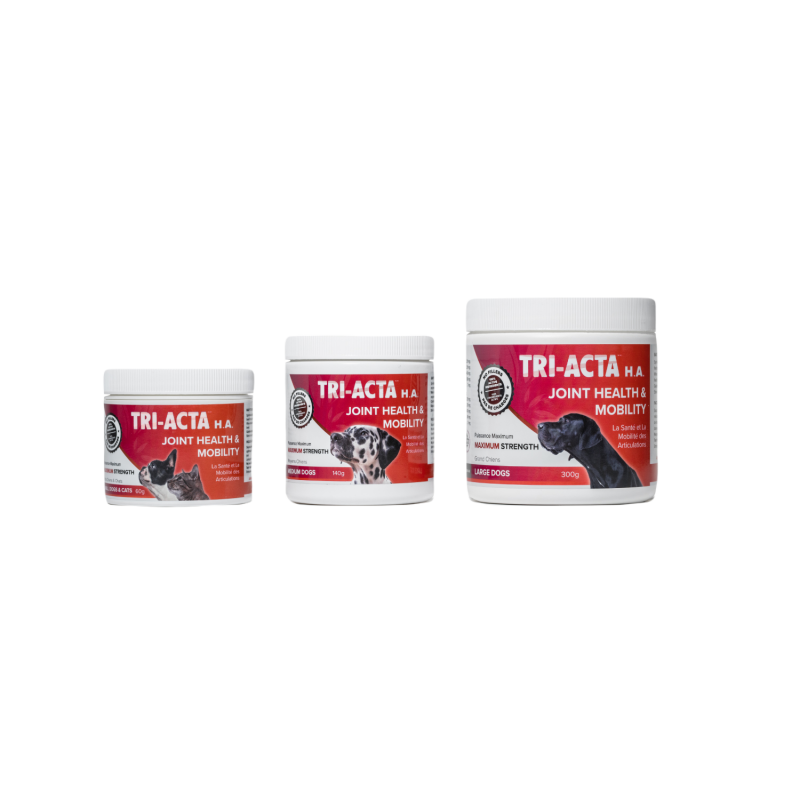

Pet Joint Supplement Manufacturing
When manufacturing a pet joint supplement, there are several factors that companies need to consider:
- Production cost
- How easy it is to transport and store
- The active ingredients that will be used
- The dosage
The answers to these questions will help the manufacturer determine whether a powder, capsule, liquid, chew, or injectable is the proper formulation for their supplement.
Some supplement ingredients can also only be made in specific formulations, so pet supplement manufacturers have to make the above choices considering the limitations of the active supplement ingredient. For example, glucosamine for dogs can come in chewable treats, tablets, liquid, and powder, but other supplements may only be viable in one type of formulation.
Further, manufacturers have to decide where to source the active ingredients used for pet health supplements. Green-lipped mussel for dogs, for example, can reduce pain, swelling, and inflammation in dogs suffering from joint issues like arthritis, but the process of farming these animals can cause significant damage to marine ecosystems. This is an important consideration that a pet health supplement manufacturer has to weigh—while green-lipped mussel is a natural ingredient and customers may look favorability at it, it also has environmental implications that may turn some customers away from the product.
Fillers in Pet Supplement Manufacturing
Fillers in pet health supplements refer to inactive ingredients present in the supplement rather than active ones, which benefit your pet. As mentioned earlier in this article, pet health supplements don’t have to undergo any specific approval process.
Instead, to get certain types of approval (which can be beneficial to gain customer buy-in) like from the American Association of Feed Control Officials (AAFCO), the supplement has to include ingredients approved as a pet food.
Many supplements, just like pet food, contain excipients. As you’ll recall, excipients are any sort of filler or binding agent, including:
- Lubricants
- Flavorings
- Colouring agents
- Coating agents
- Preservatives
- Emulsifiers (helps keep supplements moist—often used with soft chews and treats)
- Gums and resins (thickens the supplement mixture)
- Bulking agents (prevent the supplement ingredients from separating)
- Dispersing and suspending agents (helps ensure that the solids in the supplement are uniformly distributed throughout the mixture)
Excipients aren’t necessarily bad—in many cases, they are necessary to ensure that the pet health product maintains its configuration while it is being stored or to make it more palatable for your fuzzy friend. After all, even human supplements have flavors and colouring agents to make them more appealing.
The problem is that some of these ingredients can cause allergic reactions in our pets, gastrointestinal upset, or, in rare cases, serious illness. Because these ingredients don’t add any nutritional or supplemental benefit to the pet health product, it can be a tough sell when a product contains too many excipients and few active ingredients. Manufacturers have to balance the amount of inactive ingredients with active ones to ensure that their product is safe and offers good value for money.
TRI-ACTA products are made with 100% active ingredients—so you’re not paying for fillers, you’re paying for results. Being made with all active and natural ingredients means that you also don’t have to feed your pet as much of the supplement for it to be effective, so each dose goes further. Because TRI-ACTA only contains ingredients that naturally occur in your pet’s body anyway, there is also no chance of adverse effects due to the supplement.
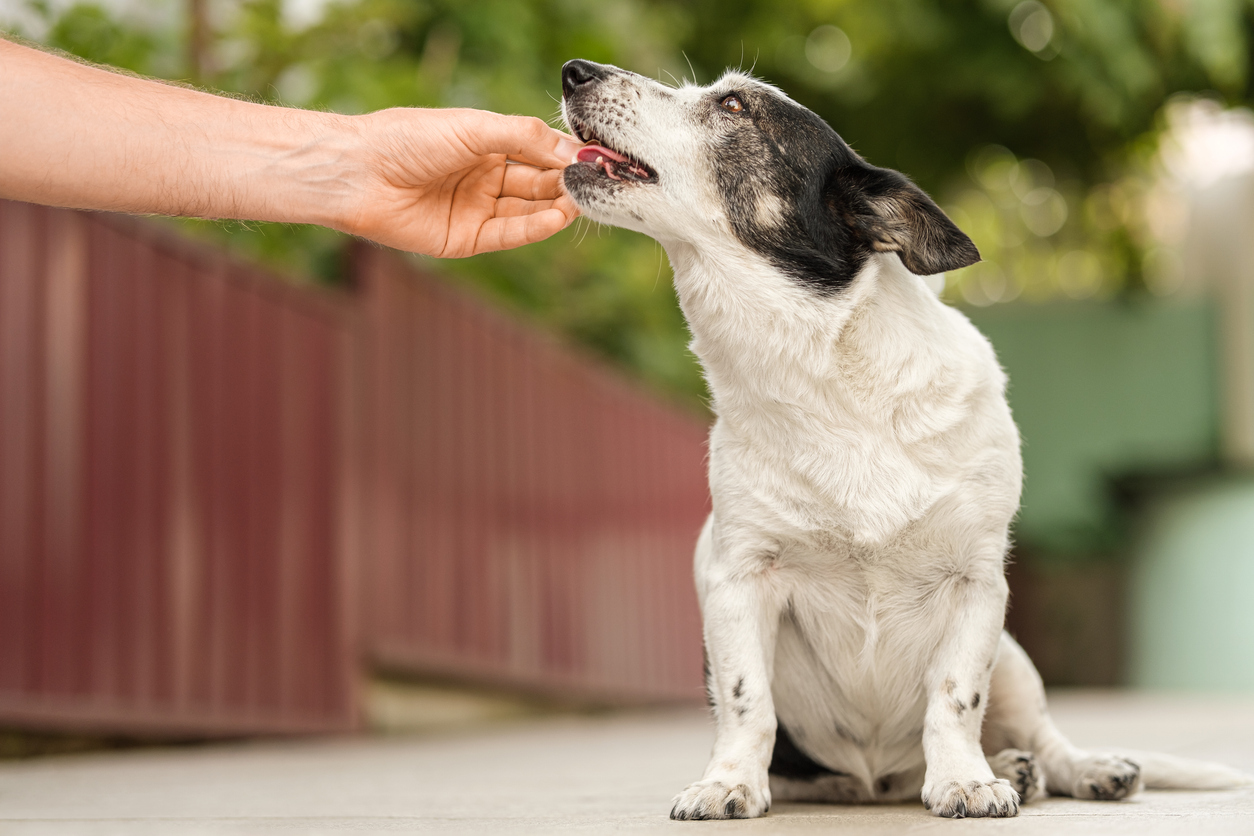
Best Joint Supplements for Pets
As you can see, many considerations go into choosing a great joint supplement for your pet. We’ve compiled a list of several different joint supplements that follow the two main factors you should look for when choosing a pet health joint supplement:
- Includes the essential joint health ingredients, glucosamine, chondroitin, MSM, and hyaluronic acid (optional, but optimal for dogs or cats that have existing joint issues)
- Has little or no fillers (non-active ingredients)
TRI-ACTA H.A.
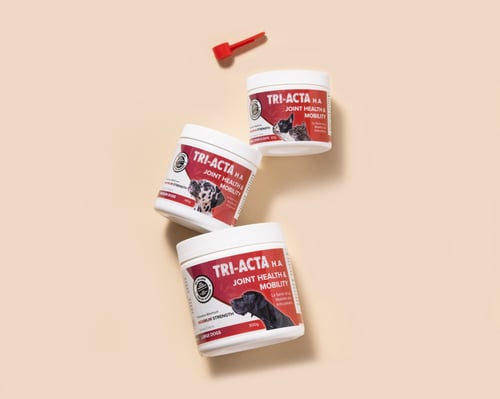
Integricare designed TRI-ACTA H.A. to be a premium pet joint health product for dogs and cats that suffer from joint issues, including arthritis, osteoarthritis, hip dysplasia, and general pain and immobility due to joint issues. It has the maximum amount of glucosamine sulphate and glucosamine HCL, MSM, Chondroitin, and hyaluronic acid. These are all naturally occurring components in your pet’s body, so there is no chance of adverse effects. Plus, because TRI-ACTA H.A. only includes active ingredients, you’re getting the maximum amount of pet health product for your money. It also means that you don’t have to give your dog or cat a high dose, a small dose is fine. For instance, even if your dog is 75-100lbs, you only have to give them a 3g dose!
TRI-ACTA H.A. is a tasteless, powder joint health supplement that can be easily sprinkled on your dog or cat’s food using the provided measuring scoop.
Starts at $27.99 CAD for a 60g container. Pricing as of June 2023.
TRI-ACTA H.A. for Pets
Our maximum strength formula is optimally designed to accelerate the formation of cartilage, minimize inflammation, expedite the healing process, and improve joint conditions.

Paramount Pet Health Liquid Glucosamine for Dogs
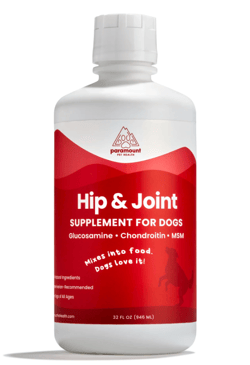
The liquid glucosamine pet health supplement option from Paramount Pet Health ticks most of the boxes on our list, as it doesn’t have a ton of fillers and contains a good concentration of the active ingredients that should be included in a joint supplement, like glucosamine, chondroitin, MSM, and hyaluronic acid. It also contains manganese chelate (which helps with bone structure and metabolism).
In addition, this supplement also:
- Made with all-natural, human-grade ingredients
- Follows GMP and is manufactured in an FDA-compliant facility
- Is transparent about the ingredients it does and does not contain
- Offers clear dosage directions
$39.99 CAD. Pricing as of June 2023.
Extend Joint Care for Dogs
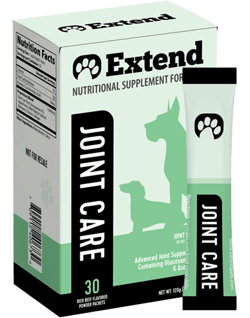
As a powdered pet joint supplement, Extend™ Joint Care contains some of the most important ingredients we like to see—glucosamine and MSM—but takes a different approach from the rest, making it more like a nutritional and joint supplement-hybrid. However, the label and website for this joint supplement are not super clear on the amount of glucosamine and MSM that the supplement contains and it does not contain any chondroitin. This is important as you need to know the amount of glucosamine you’re feeding to your pet on a daily basis to know whether it’s having any benefit or not.
In addition to the glucosamine and MSM, it also contains:
- Type II chicken collagen, which helps maintain cartilage and might help with joint and animal muscle pain (though there’s mixed evidence regarding the effectiveness)
- Ascorbic acid (also known as vitamin C) aids in the production of collagen and glycosaminoglycans (which have a wide variety of functions in the body) and aids in the delivery of nutrients to joints
$51.95 CAD. Pricing as of June 2023.
BiologicVET BioJOINT Powder for Dogs & Cats

Free of artificial colours, flavours, and binders, BioJOINT Powder for Dogs and Cats is already looking like a great option. It also contains most of the key ingredients on our list, including MSM, glucosamine, and chondroitin. Although this joint supplement contains all-natural fillers, they make up the majority of the product (flaxseed and defatted meal hull make up 72% of the product). Each dosage contains only 200 mg of glucosamine, 200 mg of MSM, and 80 mg of Chondroitin in a 5 g dosage, which means you’d have to provide further supplements (or a higher dose) to get the maximum benefit for your pet from these ingredients.
Some pros of this pet health supplement include:
- Made in Canada
- GMO-free
- Suitable for cats and dogs of all ages
$31.99 CAD. Pricing as of June 2023.
Bold by Nature+ Bone, Joint, & Immune Health
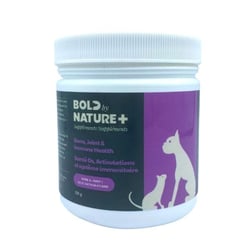
Does your dog or cat love cheese? Then they’ll probably like Bold by Nature+ Bone, Joint, & Immune Health. It’s a supplement powder that provides optimal pet health benefits, including joint protection and immune system health. It includes all-natural ingredients, including glucosamine HCL, which is a more potent type of glucosamine compared to glucosamine sulphate.
This pet joint health supplement also includes:
- Natural cheese powder (yum)
- Green-lipped mussel powder
- Turmeric powder, which is commonly used in pet health supplements to support immune health
$39.99 CAD. Pricing as of June 2023.
Head to Tail Hip & Joint For Dogs (Various Formulations Depending on Dog Size)
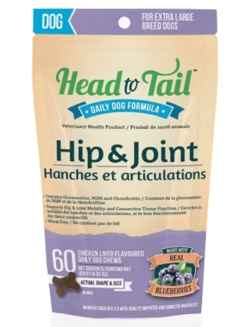
Sometimes our pups have trouble with powders or capsules but love tasty treats. Head to Tail Hip & Joint Supplements come in slightly different formulations to suit your pup’s size. Each supplement contains glucosamine, MSM, and chondroitin to support joint cartilage, fluid, and collagen. However, it’s important to note, as with any chew, you will be taking on some inactive ingredients to bind the product together.
In addition, this pet health product contains:
- Natural antioxidants like blueberries
- Some excipient ingredients like Arabic Gum, brewer’s yeast, calcium sulphate, and others, but nothing too over-the-top
- Hyaluronic acid
$43.99 CAD. Pricing as of June 2023.
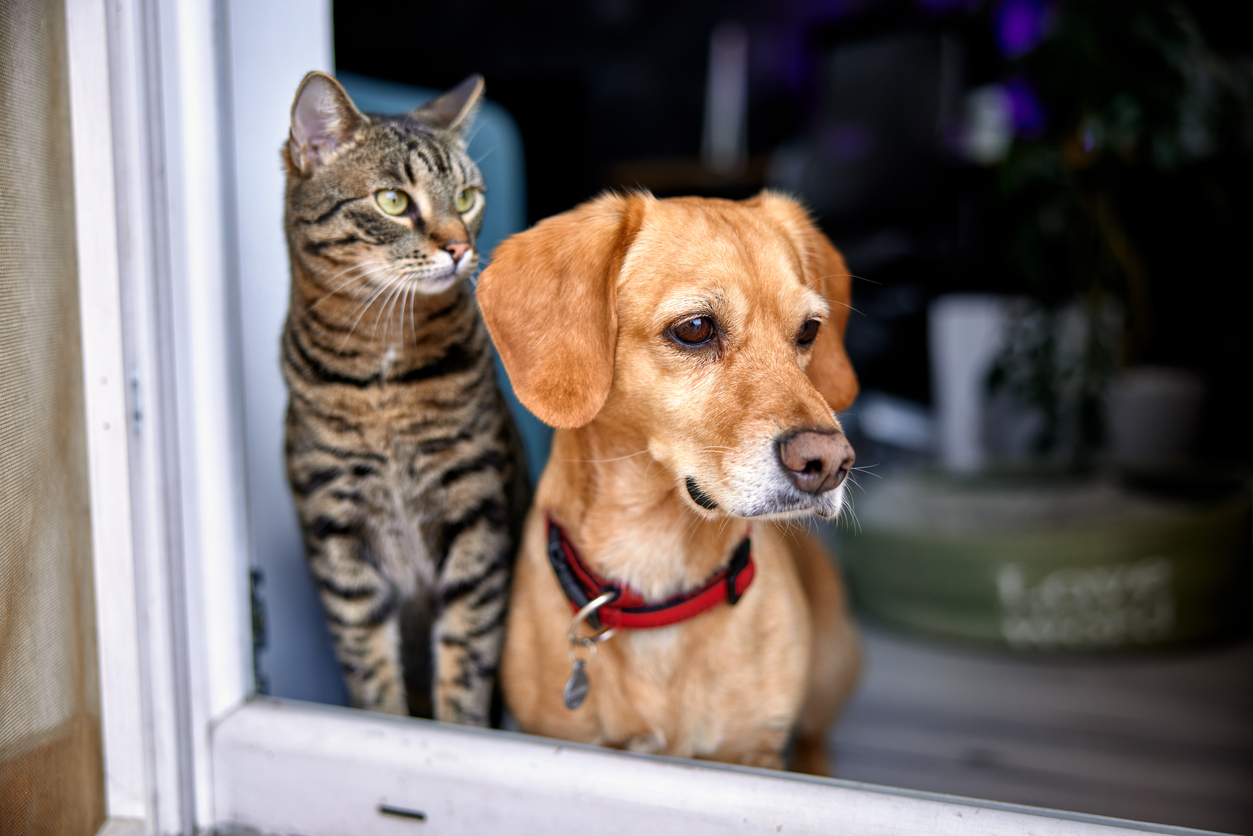
Pet Glucosamine
So far, in this article, we’ve discussed the benefits of adding a pet glucosamine supplement to your dog or cat’s diet. But what exactly is glucosamine for pets, and why is it so important to maintain your pet’s joint health over time?
Glucosamine for Pets to Help Treat Joint Pain and Issues
Just like humans, as your dog or cat ages, their body slows the production of glucosamine—an essential chemical that lubricates their joints for easy movement. Glucosamine production in dogs typically starts slowing down when they are around 4-5 years old, while with cats, we can see evidence of lessened glucosamine production when they become seniors, as between 70-90% of cats over 12 years old tend to develop arthritis.
By giving our aging dogs and cats a glucosamine supplement, we can help lessen (or even eliminate) the pain of joint conditions like arthritis. With the myriad of benefits that glucosamine for pets can provide for your dog or cat, there’s no reason not to incorporate it into your pet’s diet.
Best Sources of Glucosamine for Pets
Glucosamine for pets is made up of a combination of ingredients—glutamine, an amino acid, and glucose, a sugar. Your dog or cat naturally produces their own glucosamine to help lubricate their joints and aid in cartilage production.
There are three common forms of glucosamine for pets; Glucosamine sulphate, Glucosamine hydrochloride, and NAG N-acetyl glucosamine. About half the pet supplements on the market contain the sulphate form while the other half contain the hydrochloride form, while NAG N-acetyl glucosamine isn’t usually used for joint health.
- Glucosamine hydrochloride: Also known as glucosamine HCl, this formulation of pet glucosamine is extracted from shellfish shells. It is naturally stable, which means it does not need an extra ion to attach to it. This makes it very bioavailable and highly efficient. It’s a more concentrated version of glucosamine, and has shown positive results in dogs when given in conjunction with chondroitin sulphate.
- Glucosamine sulphate: This form can also be extracted from shellfish shells or produced synthetically in a lab. It is naturally unstable, which means it needs an extra ion to attach to it. While it is less concentrated than the HCl form, it has the unique advantage of contributing to the production of collagen. Collagen is one of three pillars that make up cartilage, and is extremely important in a healthy joint structure.
- NAG N-acetyl glucosamine: This form of glucosamine comes from the outer shells of crustaceans and is mostly used for gut health rather than joint repair.
TRI-ACTA products contain glucosamine sulphate and glucosamine hydrochloride to ensure all the unique benefits of glucosamine are made available. These are formulated in combination with chondroitin and MSM, to provide the most comprehensive and therapeutic effect for your pet’s joints.
TRI-ACTA for Pets
A proactive approach for developing and younger adult pets to maintain optimal joint health mobility, minimize inflammation and fend off age-related ailments.

An Important Note About Human Glucosamine for Pets
It’s important to know where the glucosamine you want to give your pet is sourced from and to never give your dog or cat human glucosamine. Glucosamine that’s made for humans often contains xylitol, which is a natural sweetener. Unfortunately, this sweetener can be toxic to dogs, as ingesting it can cause severe hypoglycemia (a significant decrease in blood sugar) that results in symptoms like decreased activity, weakness, staggering, incoordination, collapse, and seizures.
Interestingly, cats seem to be spared, at least for the most part, of the severe side effects of xylitol consumption, but research is still on the fence about this. This means that while some cats have been observed not to demonstrate serious side effects from xylitol consumption, it isn’t a given that your cat won’t get a serious side effect—so the best course of action is to simply avoid giving them human glucosamine.
But Can’t I Just Find Human Glucosamine Without Xylitol?
Sure, you could try to find a source of glucosamine that doesn’t contain any artificial sweetener. Still, the other issue is that glucosamine made for human consumption often contains more additives—and not all ingredients are always listed on the label. The best course of action is to purchase a glucosamine supplement that’s very clear that it’s for pets and to read the supplement's label carefully.
Benefits of Pet Glucosamine
Just like humans can take glucosamine to relieve aching joints, giving your pet a daily glucosamine supplement can provide various benefits to their overall joint health.
1. Improves Joint Mobility and Range of Motion
Glucosamine is naturally produced in your pet’s joints, where it repairs cartilage by combining it with collagen. Healthy cartilage acts as a natural sponge for your pet’s joints, acting as a shock absorber when they move.
If joint cartilage is damaged or non-existent, your dog or cat will experience pain when moving. Giving your pet a glucosamine supplement that contains chondroitin, and if they are a senior, hyaluronic acid helps their little bodies produce healthy cartilage and synovial fluid, naturally lubricating the joints. Glucosamine helps maintain synovial fluid’s viscous consistency.
2. Acts as a Natural Anti-Inflammatory
As a natural anti-inflammatory, giving your pet glucosamine will not only help them become more mobile, but it will also help reduce the pain in their joints. The effects are heightened when combined with MSM, which is another natural anti-inflammatory that your pet’s body produces.
3. Helps Treat Arthritis and Other Joint Conditions
While glucosamine isn’t a cure for arthritis, osteoarthritis, and other joint conditions your pet can potentially suffer from, it does help treat them. Giving your pet glucosamine can help lessen or even eliminate pain, help them become more mobile, and even reduce the number of NSAIDs they need to take to manage the pain resulting from their joint conditions. NSAIDs can cause secondary issues with the kidneys, liver, stomach, and intestines if taken for long periods of time, so being able to reduce the dosage or get your pet off of this medication completely is a good idea.

4. Can Potentially Help with Lower Urinary Tract Issues in Cats
In cats, there’s clinical practice evidence that giving them a pet glucosamine supplement can even help with lower urinary tract disease by helping to protect the lining of the bladder. Because urinary issues are so common in cats, this could be a great potential solution to discuss with your vet.
5. Helps Support Joints in Overweight or Obese Pets
Even though chonky kitties and dogs are super cute, the extra weight on their joints can take its toll over time, potentially leading to arthritis and other joint problems. In North America, almost 60% of cats are overweight, while around 65% of dogs are considered overweight or obese—so weight is a big issue for our furry friends.
But getting your dog or cat to exercise when their joints are hurting them is a tough chore. Giving them a joint supplement with glucosamine can help your pet’s joints withstand the extra weight and help relieve pain so that they’ll be more willing to exercise and shed the extra pounds.
Potential Side Effects
Glucosamine for pets often has few side effects overall. The risk of side effects is usually because some pet glucosamine supplements include additional ingredients that can cause allergic reactions or stomach upset. These include fillers, additives, sweeteners, flavourings, and more. As a general rule, as long as you’re giving your pet glucosamine from a reputable pet product company, your pet will be fine.
In rare cases, your pet can also be allergic to glucosamine. For example, if your dog has a sensitivity or allergy to shellfish, you would want to avoid glucosamine products sourced from shellfish. Glucosamine sulphate and glucosamine hydrochloride can be sourced from shellfish shells, but synthetic versions can also be made in a lab. Still, an extreme allergic reaction to glucosamine is rare in dogs.
There’s also been some evidence that giving glucosamine to dogs with liver or kidney issues can exacerbate these issues, so it’s best to discuss whether it’s worth giving your dog a glucosamine supplement if they suffer from these ailments.
It’s best to choose a supplement that contains as many active ingredients as possible to limit your pet's potential to experience adverse effects. TRI-ACTA products contain 100% active ingredients, meaning no fillers or additives, so your pet can benefit from the positive effects of the joint supplement without you having to worry about allergies or other adverse reactions.
Dosage
Although adverse effects from a glucosamine overdose are rare, you should still monitor your dog’s behaviour when giving them any new medication or supplement. If you note changes in their behaviour and haven’t changed anything else surrounding their diet or daily routine, it’s worth checking in with your vet just in case.
General dosage directions for glucosamine for dogs is as follows:
|
Glucosamine Dosage |
Dog’s Weight |
|
250-500mg |
5-20lbs |
|
500mg |
25-40lbs |
|
1,000mg |
45-90lbs |
|
1,500mg |
90+ lbs |
The dosage for glucosamine for cats is also usually based on weight. For a typical kitty, you should give them between 120 and 500mg of glucosamine daily. However, actual dosage may vary depending on the supplement you pick, and your veterinarian’s recommendation.
For example, TRI-ACTA for pets is suitable for cats and dogs, and suggests a dosage based on weight, since the supplement only contains active ingredients with no fillers. For a dog or cat under 10lbs, you’d give them 0.5g of product per day, which is 250mg of glucosamine. But if your pet is over 10lbs, then you’re directed to give them 1g per day, which, of course, equals out to 500mg of glucosamine.
What Happens if My Pet Gets Too Much Glucosamine?
If your pet consumes too much glucosamine (for instance, they get into the container when you’re not around) they can potentially experience general gastrointestinal symptoms, such as:
- Nausea
- Vomiting
- Diarrhea
- Lethargy
However, it is important to pay attention to the additives in the supplement that you’re giving your pet, as these are more likely to be the culprit of the issues your pet is experiencing rather than the glucosamine itself.
Best Glucosamine for Pets
When choosing a glucosamine supplement to give to your pet, look for reputable brands that have positive customer reviews and are transparent with the ingredients they include in their product.
Here are some recommendations for the best glucosamine supplements for pet health:
TRI-ACTA for Pets
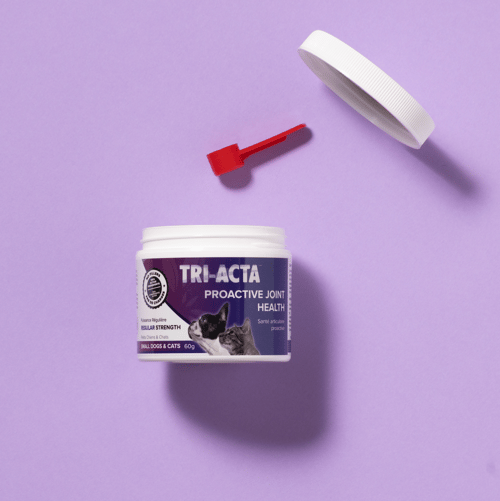
TRI-ACTA for pets was developed by Integricare as a daily solution for maintaining your pet’s joint health. It has the unique benefit of using two types of glucosamine for maximum absorption and collagen production. It combines both forms of glucosamine with chondroitin, to promote the generation of new, healthy cartilage, muscle, and ligaments in your pet’s joints. The glucosamine and chondroitin in TRI-ACTA work alongside MSM, a natural anti-inflammatory, to provide a complete joint health solution for your pet.
Because TRI-ACTA only contains active ingredients, you only need to administer a small dose to your pet (based on weight) for maximum effectiveness. Also, because there are only active ingredients in the supplement, you essentially eliminate the risk of your pet getting adverse reactions due to the supplement.
Starts at $23.99 CAD for a 60g container. Pricing as of June 2023.
TRI-ACTA for Pets
A proactive approach for developing and younger adult pets to maintain optimal joint health mobility, minimize inflammation and fend off age-related ailments.

Dr. Joseph’s VetPro Complete Hip & Joint
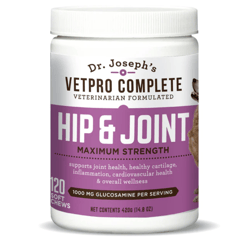
With over 30 years of experience developing veterinary pet health products, Dr. Joseph formulated this hip and joint glucosamine supplement to provide the maximum amount of glucosamine per chewable. Because it’s a chewable supplement designed to act like a tasty treat for your pet, it contains various inactive ingredients. However, the product is transparent about what these ingredients are, and many of them are ingredients that you’d find in standard pet food anyway.
$53.65 CAD. Pricing as of June 2023.
GlycoFlex® Plus Hip & Joint Supplement for Cats
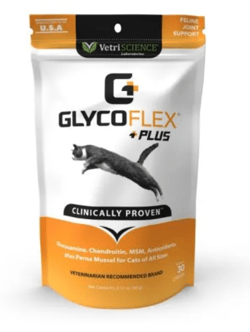
If you have an older cat, this chewable joint health supplement with glucosamine, chondroitin, MSM, and anti-oxidants is a great choice. The ingredients are mostly all-natural, with the glucosamine coming from green-lipped mussels sourced from New Zealand. Manufactured in the USA and only using highly-researched ingredients, you can rest easy knowing that you’ve chosen a great pet health supplement. Your kitty will surely enjoy the fishy flavour of these chewable supplements, too!
$15.93 CAD. Pricing as of June 2023.
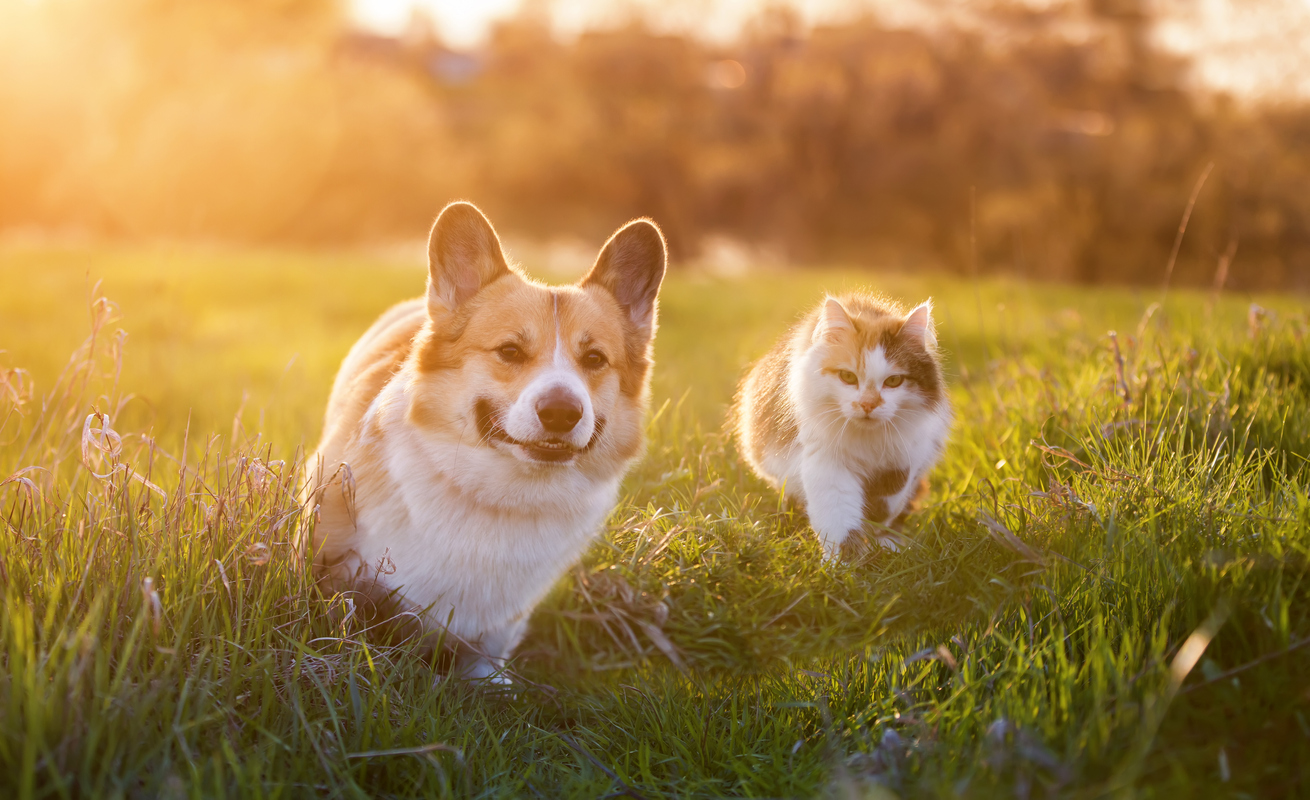
Pet Health Care & Wellness
As pet owners, we want our pets to be as healthy and happy as possible. After all, they are important family members. In between redirecting your cat with a wand toy from scratching the couch or hiding your shoes in the closet to prevent Fido from chewing them, you might be thinking about all the different pet wellness conversations you’ve heard. Whether it’s a good idea to look into a dog bland diet or read more about the benefits of fish oil for cats, this section closely investigates what you need to know about pet health.
Pet Wellness Concerns
Some common pet health concerns that weigh on the majority of pet owner’s minds include:
Weight Gain in Dogs
A dog is considered obese when his body mass index (BMI) exceeds 27.5. Body condition scoring is also used, which is a system that is used for both cats and dogs to determine ideal weight based on weight, muscle mass, and bone density. A score of 4-5 out of 9 is considered optimum.
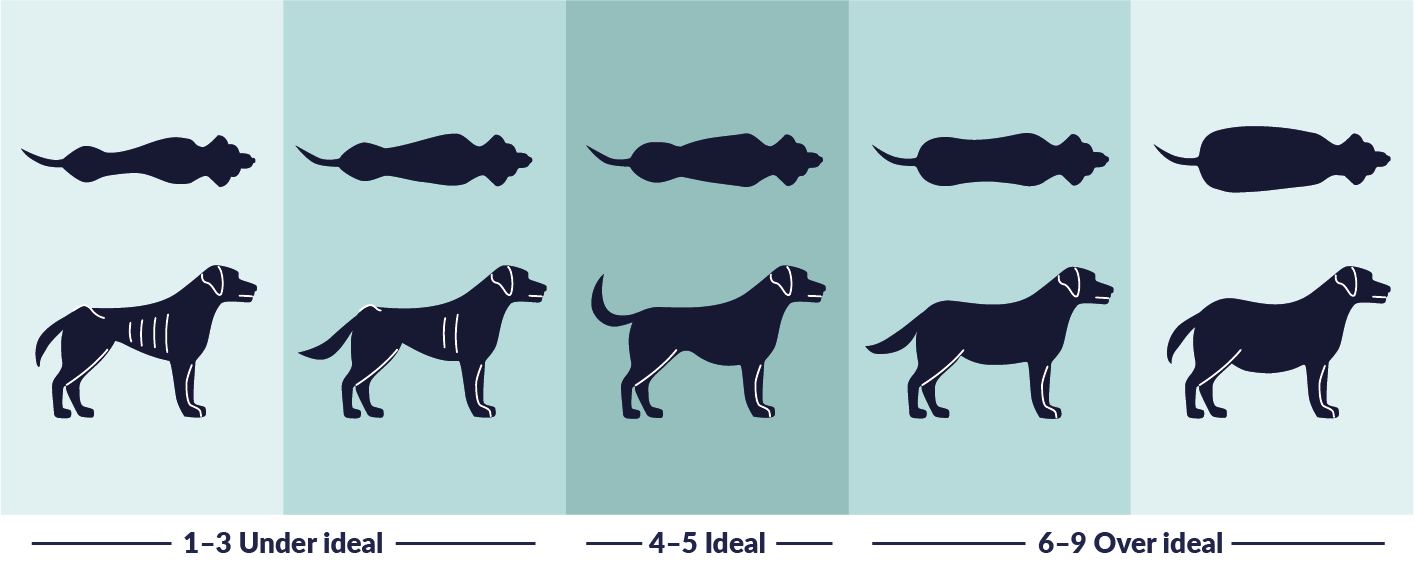
Obviously, the ideal weight for a dog highly depends on its breed and overall size. A Chihuahua will have a much lower ideal weight than a Husky. Dogs can become obese because of genetics, diet, lack of exercise, or certain health conditions, such as polycystic ovarian syndrome or Cushing’s disease.
Obese dogs have an increased risk of serious health conditions like heart disease, diabetes, liver disease, and joint conditions. These conditions can significantly impact your dog’s quality of life and, unfortunately, in some cases, can even lead to death.
If your dog suddenly starts gaining weight, finding the underlying cause can be difficult. Your vet can perform blood work to determine if there are any abnormalities that may reveal the underlying cause. Many common causes of obesity in dogs can be treated with diet changes, increased exercise, and medications. More serious ailments may require surgery.
If you and your vet have ruled out any underlying conditions causing your dog to gain weight, it’s probably time to examine their diet. Your vet can help you develop a weight loss plan, but you’ll also likely want to look into healthy treats and food options to feed your dog.
Diet dog food, for instance, offers several pet health benefits for your overweight pooch:
- Has low caloric content while still meeting your dog’s nutritional needs
- Relies on fewer fillers like soy and corn and instead prioritizes ingredients like chicken and other sources of protein
- Often contains less sodium, which can help with your pup’s blood pressure and support heart health
- Lessens the risk of diabetes by reducing complex carbs, such as corn, soy, and rice
- Can help with skin and coat problems caused by a diet lacking in fatty acids by including fish oils and other Omega-3 Fatty Acids
Weight Gain in Cats
Like dogs, obesity is a problem for many of our beloved feline friends. A cat is considered overweight when their weight exceeds 10-20% above their ideal body weight. If a cat weighs above 20% of their ideal body weight, they are considered obese. In cats, obesity can also be diagnosed using the body condition scoring system, with a score between 4-5 out of 9 being an ideal weight.
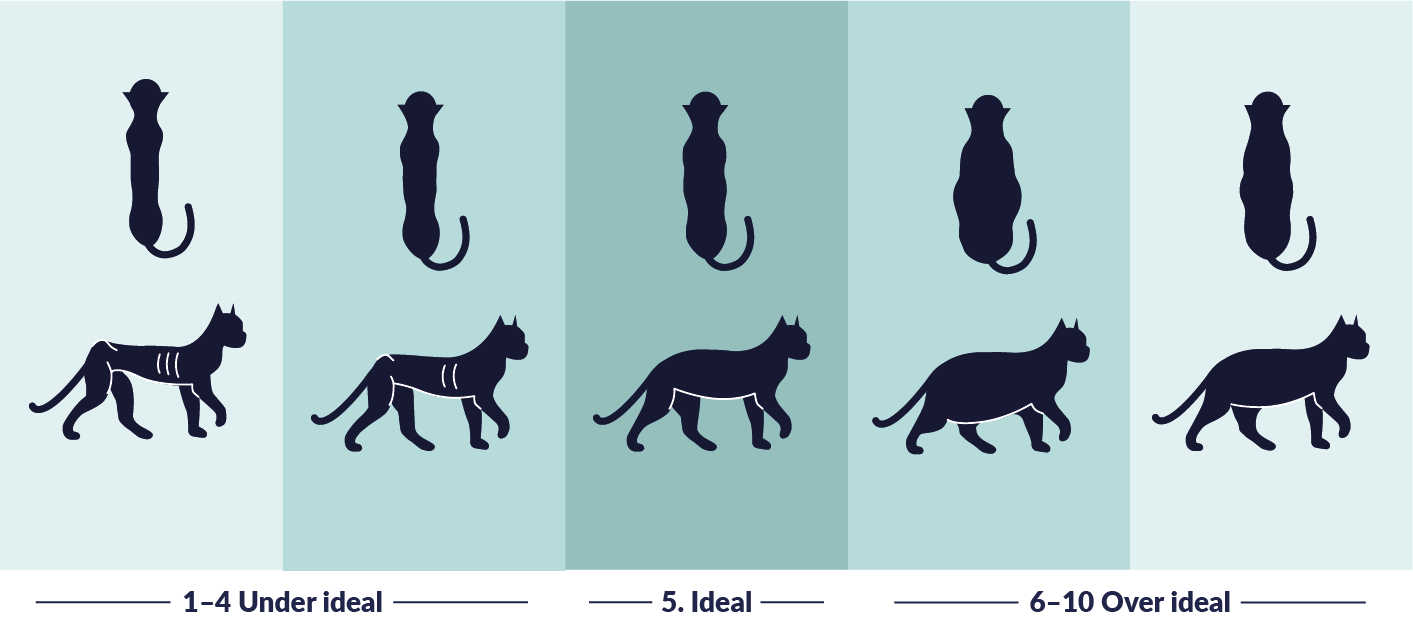
Aside from performing a blood test to determine if any underlying conditions are responsible for your cat’s sudden weight gain, your vet will also perform a physical examination. This examination can help determine what score your cat falls under with regard to the body condition scoring system.
These are the areas that your vet will access (and you can do it too!):
- Look and feel the ribs, spine, and pelvis
- Look at the waist of the cat, also referred to as the abdominal tuck
- Assess the amount of muscle and fat present
- Look at the cat from the side and from above
|
Body Condition Score |
Description |
|
1-3 |
While the ribs, spine, and pelvic bones are easily visible on short-haired cats, a very narrow waist, severe abdominal tuck, and small amounts of fat and muscle indicate that the cat is underweight. |
|
4-5 |
Ribs are not visible but are easily felt. The waist is obvious, with a slight abdominal tuck. Overall, the body feels well-proportioned, and there are small amounts of abdominal fat. |
|
6-7 |
Ribs cannot be felt, and the waist isn’t visible. There is also abdominal distention, but it’s subtle. |
|
8-9 |
Ribs cannot be felt, and the waist isn’t visible. There is also abdominal distention, but it’s subtle. With a 9 score, the ribs are covered by an obvious thick layer of fat, and abdominal distention. |
Joint Health Concerns in Dogs and Cats
Dogs and cats are active animals, and the potential for joint problems comes with that activity. If your dog or cat is overweight, that can also cause joint issues. It’s important that you keep your pet at a healthy weight, but it’s also important to supplement their diet with pet joint supplements. TRI-ACTA can be given to dogs and cats and is easy to administer.
TRI-ACTA H.A. for Pets
Our maximum strength formula is optimally designed to accelerate the formation of cartilage, minimize inflammation, expedite the healing process, and improve joint conditions.

Raw Diet for Dogs and Cats
From kibble to wet food, determining the best food for your pet can be difficult. A common trend nowadays is to feed your dog or cat a raw diet consisting of organ meats, muscle, whole or ground bone, raw eggs, fruit, vegetables, and more.
The benefits of feeding a raw food diet for dogs include:
- Shinier coats
- Improved overall skin health
- Better breath and cleaner teeth
- Increased energy levels
- Improved stools
The benefits of feeding a raw food diet for cats include:
- Improved digestion
- Reduced stool odour and volume
- Healthier coat, less shedding, and fewer hairballs
- More energy
- Better dental and urinary health
When developing a raw diet for your dog or cat, it’s best to consult your vet to ensure that you include all the nutritional elements they need. It can be easy to overlook certain nutrients that your dog and cat need when feeding a raw diet.
Natural Pet Health Remedies
Natural products have become increasingly popular for people, so it makes sense that we’d like to use these remedies for our pets as well. Here are some common natural pet health remedies that can be used to treat a variety of pet health conditions:
- Fish oil is a great natural source of Omega-3 Fatty Acids and can be added to your dog or cat’s diet through a supplement. Some pet joint health supplements also include fish oil for its ability to help lubricate joints. Fish oil is also great for helping your dog or cat maintain a shiny coat and healthy skin.
- Yogurt and Pumpkin are often used to help relieve digestive upset in pets. It’s important not to give your pet just any yogurt, however, as the lactose content can make them even sicker, and artificial sweeteners can be toxic. The best type of yogurt to give your pet is plain, unsweetened, xylitol-free greek yogurt. With pumpkin, purchase plain and unsweetened pure pumpkin—no pie filling or similar product. Usually, the recommended dose for pumpkin is 1–4 tablespoons.
- Chamomile spray is a great remedy for dogs and cats to relieve irritated skin. Simply prepare the tea as normal, let it cool, and transfer the cold tea to a spray bottle. Spray the affected area with the chamomile to give your pet instant relief. The spray can be stored in the fridge.
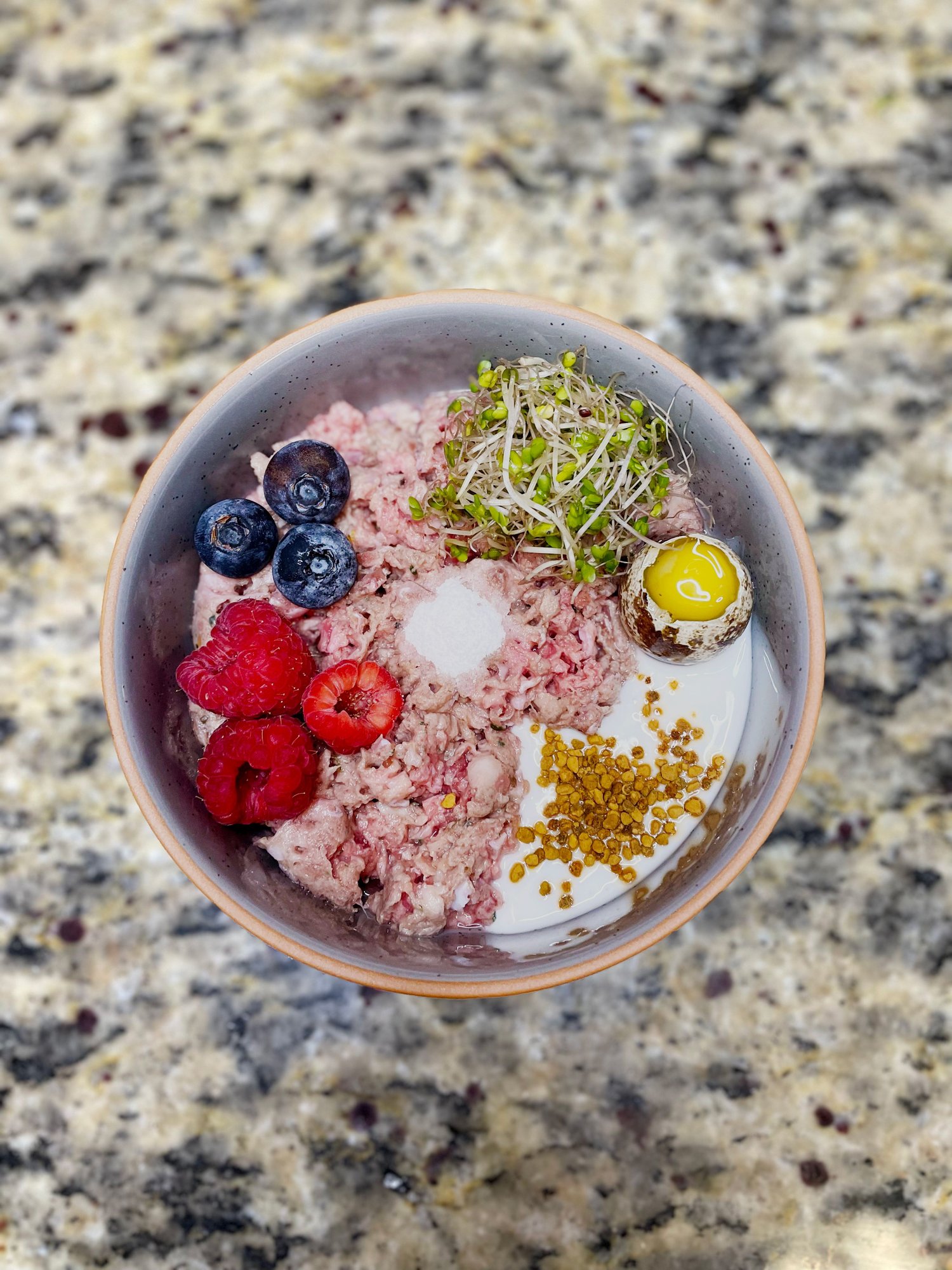
Pet Health Supplements
There are a variety of pet health supplements that you can give to your pet to aid in their overall health and wellness. These supplements include:
Joint Supplements
To ensure that your dog or cat stays free from joint pain well into their golden years, giving them an effective joint supplement daily is important. TRI-ACTA is a safe and effective joint supplement that is formulated for daily use and contains no artificial ingredients or fillers.
TRI-ACTA H.A. for Pets
Our maximum strength formula is optimally designed to accelerate the formation of cartilage, minimize inflammation, expedite the healing process, and improve joint conditions.

Probiotic Powder
Just like us, sometimes your pets can experience gastrointestinal issues. This can sometimes be because their gut flora is out of whack. Giving your pet probiotic powder (there are different formulations for dogs and cats) can be an effective way to get their digestion back in normal working order.
Calming Chews
Sometimes, our animals can become anxious, scared, or have trouble calming down. This can be due to a storm, which can stress out dogs and cats, because of a new environment, or for other reasons. Calming chews are an easy way to help your pet relax and can be given the same way as a regular treat.
Pet Health Care Tips
Here are some actionable tips to keep in mind to ensure your pet stays healthy and happy.
1. Listen to and Understand Your Pet
Keeping our pets healthy isn’t always as straightforward as it seems. Individual dogs and cats can have vastly different personalities, and with those different personalities come quirks. Over time, you’re going to naturally get to know your pet’s unique personality. This is important not only so that you can pick the toys and food you know they’ll like but also to alert you when they aren’t feeling so hot.
For instance, if your dog is usually a happy-go-lucky boy who is down for a walk whenever and wherever and suddenly shows no interest when you grab the leash, chances are that something’s amiss, and you should take a trip to the vet.
2. Avoid High-Impact Exercise with Your Pet Recovering From Joint Issues
If your pet has joint issues or is recovering from them, avoid high-impact exercises like fetching, running, or jumping. This can cause additional stress on your pet’s joints that could result in making an injury worse or re-injuring a joint that’s healed. Instead, focus on exercise that is not as stressful on their joints, like walking or swimming.
3. Always Spay and Neuter Your Pets
Populations of dogs and cats are often out of control worldwide. If you’re unsure whether it’s a problem in your area, talk to a local rescue. Chances are they will inform you of how swamped they are with the intake of new kittens and puppies as they scramble to find homes for them all. When you spay and neuter your pet, you’re demonstrating responsible pet ownership by not contributing to an overwhelming population of dogs and cats. Also, spaying and neutering can prevent diseases and conditions related to your pet’s reproductive organs from developing.
Recommended Pet Wellness Programs
Pet wellness programs refer to activities that are meant as either preventative care or to help a pet that’s experienced trauma or disease to get better. Thankfully, there are a wide variety of pet wellness programs out there that are tailored to help your pet in certain situations. Here are some examples:
Hydrotherapy
Hydrotherapy is an effective exercise option for overweight animals or animals that have weakened joints due to other conditions. The water helps the animal be buoyant and reduces the weight on their joints, making it more comfortable for them to walk. This can help them shed extra pounds while strengthening their joints over time.
Here’s one instance where hydrotherapy is used to help a cat hit by a car regain his ability to walk properly using his front legs. While the therapy could potentially take years, it’s nice to know that there’s an option to help pets that experience this sort of trauma.
Veterinary Laser Therapy
This innovative pet treatment option has recently gained popularity as an alternative therapy option. Laser pet therapy can be used in place of or in conjunction with medication like NSAIDs to reduce inflammation, pain and assist with wound healing.
Therapeutic lasers use light waves to cause photobiomodulation, which alters cellular and tissue physiology. The light absorbed by cells stimulates them to grow, heal, and repair.
Laser therapy helps repair tissue by causing the tissue to promote:
- The release of endorphins
- Vasodilation, which increases blood flow to bring in oxygen and cells to speed up the healing process
- Muscle relaxation
- Decreased inflammation
Acupuncture
Certain ailments your pet may be suffering from, like digestive issues, hip dysplasia, or certain neurological disorders, can be helped by acupuncture.
Acupuncture in pets is usually recommended in conjunction with other treatments, like medication and surgery, to help your pet heal. Just like a regular acupuncture session with people, needles are inserted into certain areas of your pet’s body to stimulate nerves, muscles, and fascia to stimulate neurotransmitters in the brain to relieve pain.
However, acupuncture is not a method that works for every single pet. Pets that are sensitive to touch or don’t like being held would not be suitable candidates for acupuncture.

Final Thoughts on Pet Health
Keeping our pets happy and healthy as they age is a top priority for pet owners. But, with so many pet health products and information out there, it’s important to perform your due diligence before purchasing any pet health product. This includes reading articles from reputable sources as part of your research process, reading reviews, and seeking out recommendations and expertise from your vet. We also have pet health recommendations that you can follow from our animal health partners.
One effective pet health supplement that you can rely on to be a safe and effective way to ensure that your pet maintains strong joints is TRI-ACTA. Designed to be given to your pet daily, TRI-ACTA is a pet joint supplement that promotes healthy cartilage production, helps maintain collagen and connective tissue, protects joint tissues, decreases stiffness, and overall improves your pet’s mobility.
TRI-ACTA for Pets
A proactive approach for developing and younger adult pets to maintain optimal joint health mobility, minimize inflammation and fend off age-related ailments.

Contact us with any questions about Integricare products, or find a retailer near you.

